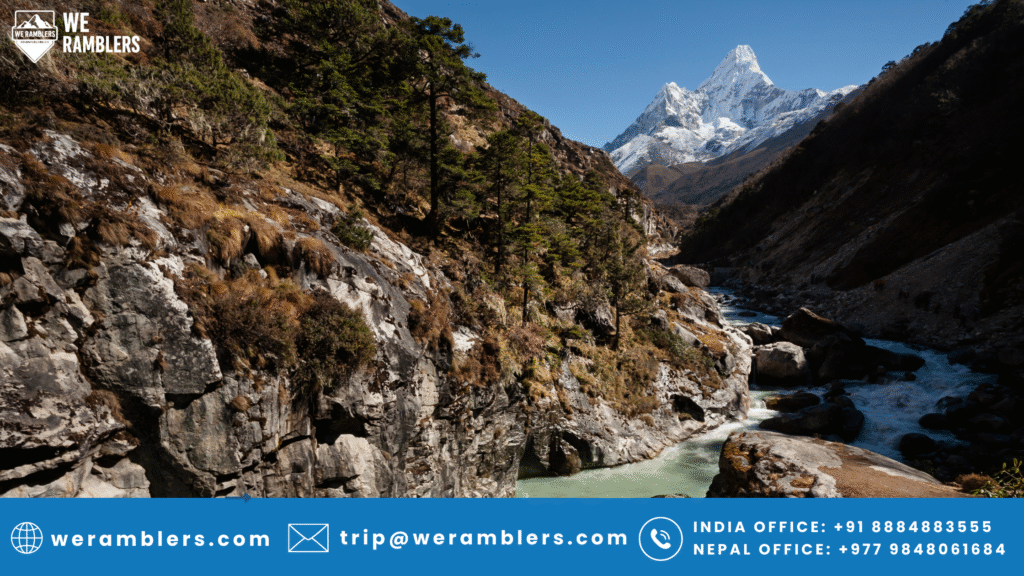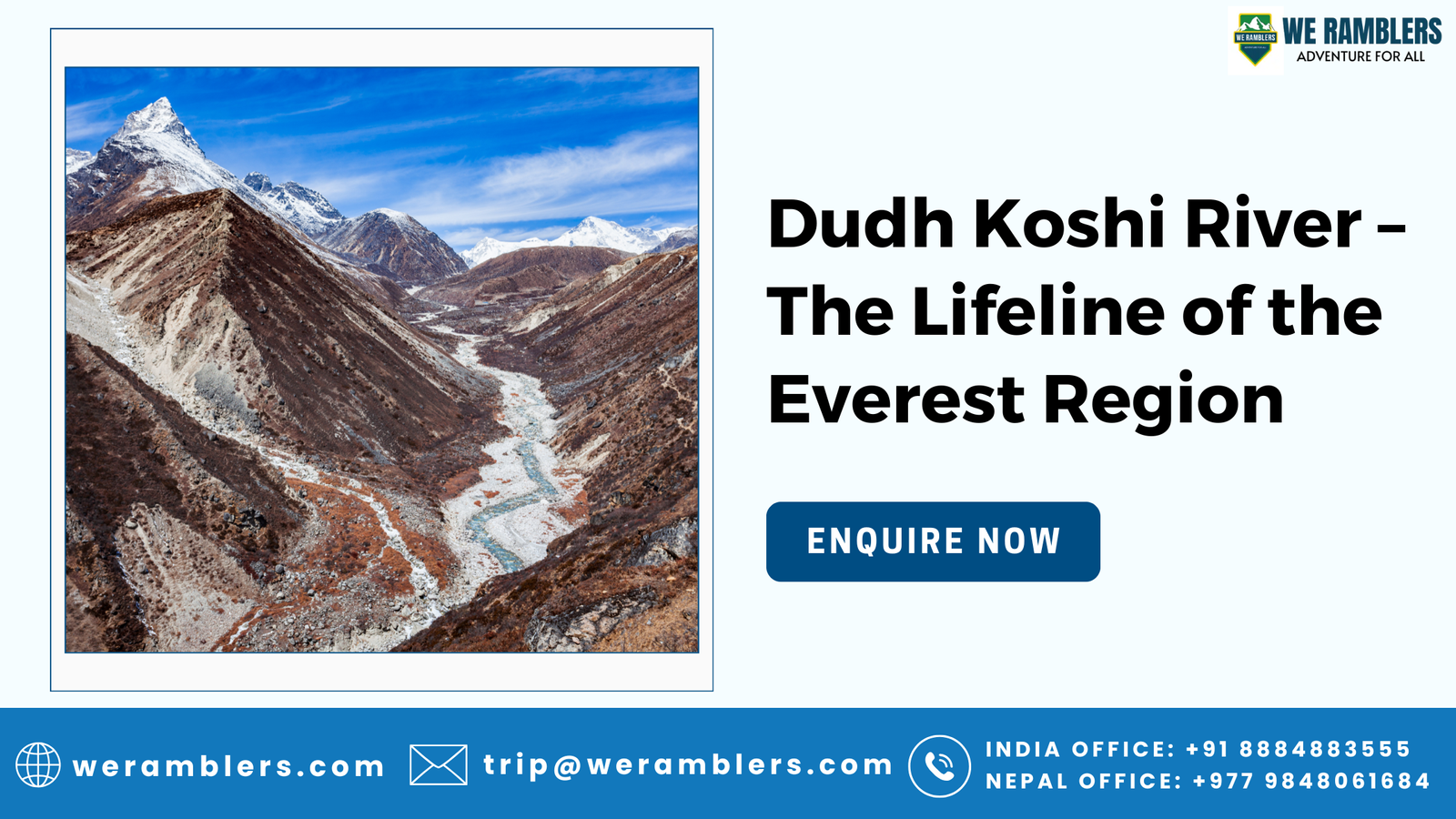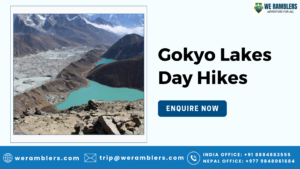Dudh Koshi River – The Lifeline of the Everest Region
Flowing wild and free through the heart of the Khumbu Valley, the Dudh Koshi River is more than just a glacial stream; it’s the spiritual and geographical artery of the Everest region. For trekkers making their way to Everest Base Camp, this fast-flowing Himalayan river is a constant companion, shaping the landscape, enriching local culture, and offering unmatched scenic beauty.
In this blog, we explore everything about the Dudh Koshi River in Nepal, from its glacial origin and cultural significance to its role in Sherpa livelihoods, ecotourism, and guided trekking.
Glacial Origins of the Dudh Koshi River
The Dudh Koshi River is born from the icy meltwaters of the Khumbu Glacier, just below Mount Everest, the world’s highest peak. As the glacier melts due to the intense Himalayan sun and seasonal temperature shifts, it gives rise to a milky, sediment-rich river that begins its journey through the Sagarmatha National Park.
This glacial river of Nepal flows southward from the base of Everest, carving through narrow gorges, valleys, and alpine forests. The Khumbu region is part of the Solu-Khumbu district, one of Nepal’s most iconic trekking zones, and Dudh Koshi is its lifeblood.
What Does “Dudh Koshi” Mean?
The name “Dudh Koshi” comes from the Nepali words “Dudh”, meaning milk, and “Koshi”, meaning river. Literally translated, it means “Milk River,” referencing the river’s distinct milky-white appearance, caused by suspended glacial silt particles.
This unique visual identity gives the river a sacred, otherworldly presence, especially when viewed from the numerous suspension bridges or high Himalayan trails.
Course, Flow & Tributaries
Where is the Dudh Koshi River located? The Dudh Koshi begins its journey in the high altitudes of the Everest region and flows down through the eastern Himalayas, eventually merging with the Sun Koshi River, which later becomes part of the mighty Ganges river system.
Key tributaries of the Dudh Koshi include:
- Imja Khola – Flowing from the Imja Glacier near Island Peak
- Bhote Koshi – Merges at Namche Bazaar, adding volume and strength
- Smaller streams and waterfalls from the Gokyo Lakes region
As it descends, the river supports both ecosystems and communities, making it one of Nepal’s most important Himalayan river systems.
Everest Base Camp Trek: River Crossings on the Trail
One of the most memorable features of the Everest Base Camp Trek is the series of suspension bridge crossings over the Dudh Koshi River. These dramatic crossings, some hundreds of feet above the roaring river, occur along the route from Lukla to Namche Bazaar, and are often festooned with colorful Tibetan prayer flags.
These bridges provide trekkers with thrilling photo opportunities and a visceral sense of being high in the Himalayan wilderness. It’s a reminder that the trek is not just about Everest, it’s about the journey through an incredibly vibrant, living landscape.
Important Note: As of 2023, solo trekking is prohibited in Nepal. All treks in regions like Everest, Annapurna, and Langtang must be done with a certified guide, and permits are strictly enforced. At We Ramblers, we ensure all our trekkers are accompanied by experienced, licensed professionals.

Sherpa Culture & Livelihoods Along the Dudh Koshi River
The Dudh Koshi River plays a critical role in sustaining Sherpa villages like Phakding, Monjo, Tengboche, and Namche Bazaar. These communities rely on the river for freshwater, agriculture, and tourism-based livelihoods.
Sherpas have deep spiritual connections to natural elements like rivers and mountains. Chortens (Buddhist shrines), mani walls, and prayer wheels often line the trails near the river, adding layers of meaning and beauty to your trek.
The river also powers small hydropower plants, which support the needs of remote villages, showcasing a balance between traditional culture and modern sustainability.
Scenic Beauty & Photography Opportunities
With turquoise glacial waters, dramatic cliffs, snow-covered peaks, and pine-lined valleys, the Dudh Koshi River is a paradise for photographers and nature lovers. Whether it’s a long-exposure shot of water streaming past boulders or a wide-angle view of Ama Dablam rising above the valley, this river is a visual treat.
Suspension bridges, waterfalls, and monasteries perched on hillsides add to the dreamlike appeal of this region, perfect for Instagram-worthy moments and travel documentaries.
Ecological Importance & Biodiversity
The Dudh Koshi River flows through the Sagarmatha National Park, a UNESCO World Heritage Site known for its unique Himalayan biodiversity. The riparian zone around the river supports rare plant species, alpine forests, and a range of wildlife.
You may spot:
- Himalayan monal (Nepal’s national bird)
- Red pandas (in forested sections)
- Snow leopards, musk deer, and langurs (though sightings are rare)
This river ecosystem is crucial to maintaining biodiversity in the Eastern Himalayas, and it plays an important role in sustainable ecotourism.
Rafting and White-Water Kayaking
While the upper stretches of the Dudh Koshi are too narrow and fast for commercial rafting, some lower tributaries and sections further downstream near the confluence with the Sun Koshi may offer white-water kayaking opportunities for experienced paddlers.
That said, the region is more famous for its trekking trails than for river-based adventure sports. Always ensure that you explore with licensed adventure guides and proper safety measures.
Cultural & Spiritual Significance of Dudh Koshi River
In Buddhist culture, rivers are sacred, seen as symbols of life, purity, and renewal. The Dudh Koshi is no exception.
Monasteries like Tengboche and Pangboche (major spiritual centers in the Everest region) are located close to the river, and you’ll often see prayer flags fluttering in the wind, mani stones etched with sacred chants, and Lamas performing rituals near the water’s edge.
These traditions reinforce the river’s status not just as a geological feature, but as a living presence in local spirituality.
Treks That Follow or Cross the Dudh Koshi River
Several world-famous treks either follow or intersect the Dudh Koshi River, including:
- Everest Base Camp Trek
- Gokyo Lakes Trek
- Everest Three Passes Trek
- Phaplu to Lukla Trek
Most treks start from Lukla and trace the river’s flow through Phakding, Monjo, and Namche Bazaar, giving trekkers constant visual and auditory access to this powerful waterway.
We Ramblers – Explore the Himalayas Responsibly
At We Ramblers, we believe in responsible, guided adventure travel that immerses you in the raw beauty of Nepal while ensuring your safety and comfort.
We offer expertly curated treks in the Everest region, including Everest Base Camp, Three Passes Trek, Gokyo Ri, and more. Our experienced local guides are certified, culturally aware, and trained in altitude protocols.
As an adventure travel company that prioritizes sustainability, eco-consciousness, and local community engagement, We Ramblers is your trusted companion in the mountains.
Frequently Asked Questions (FAQs) About Dudh Koshi River
1. Why is Dudh Koshi famous?
The Dudh Koshi River is famous for its glacial origin from the Khumbu Glacier near Mount Everest and for flowing through the Everest Base Camp trekking route. Known as the “Milk River” for its milky appearance, it is revered for its natural beauty, Sherpa cultural importance, and dramatic suspension bridge crossings that trekkers encounter between Lukla and Namche Bazaar.
2. Where is the Dudh Koshi river located?
The Dudh Koshi River is located in the eastern Himalayas of Nepal, flowing through the Solu-Khumbu district in the Everest region. It originates from the Khumbu Glacier near Mount Everest and flows southward through Sagarmatha National Park, eventually merging with the Sun Koshi River.
3. How to reach Dudh Koshi?
To reach the Dudh Koshi River, travelers typically fly from Kathmandu to Lukla, the gateway to the Everest region. From Lukla, guided treks follow the trail alongside the Dudh Koshi River toward Namche Bazaar and beyond. A certified guide is required for trekking in this area as per Nepal’s 2023 trekking regulations.
4. How to go to Dudh Koshi from Delhi?
From Delhi, fly to Kathmandu, Nepal’s capital. Then, take a domestic flight to Lukla, the starting point of most Everest region treks. From Lukla, the Dudh Koshi River can be accessed on foot as part of a guided trekking route toward Namche Bazaar and Everest Base Camp.





